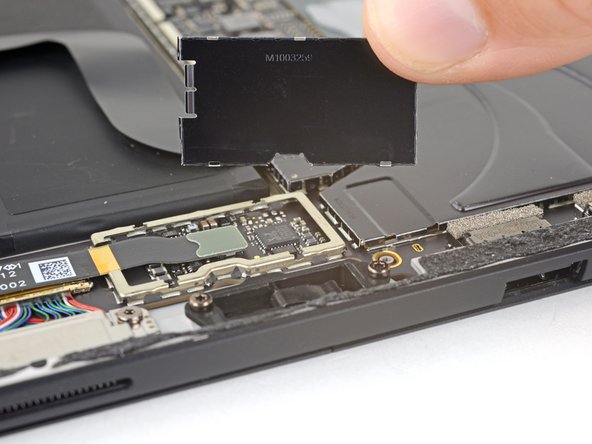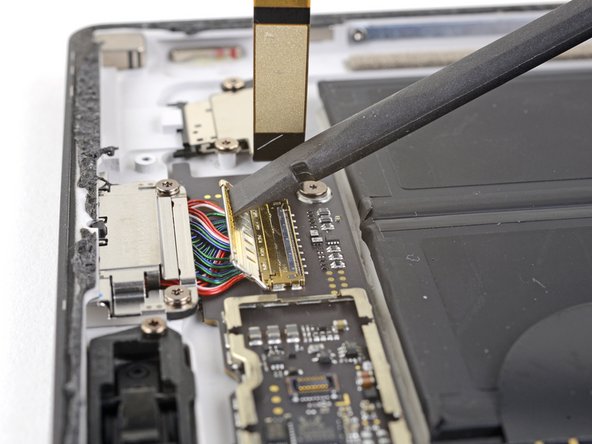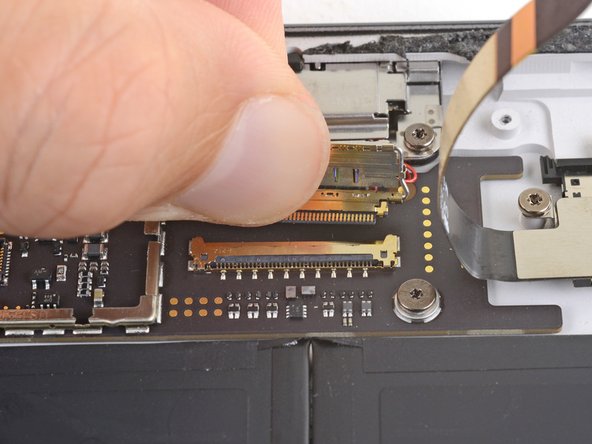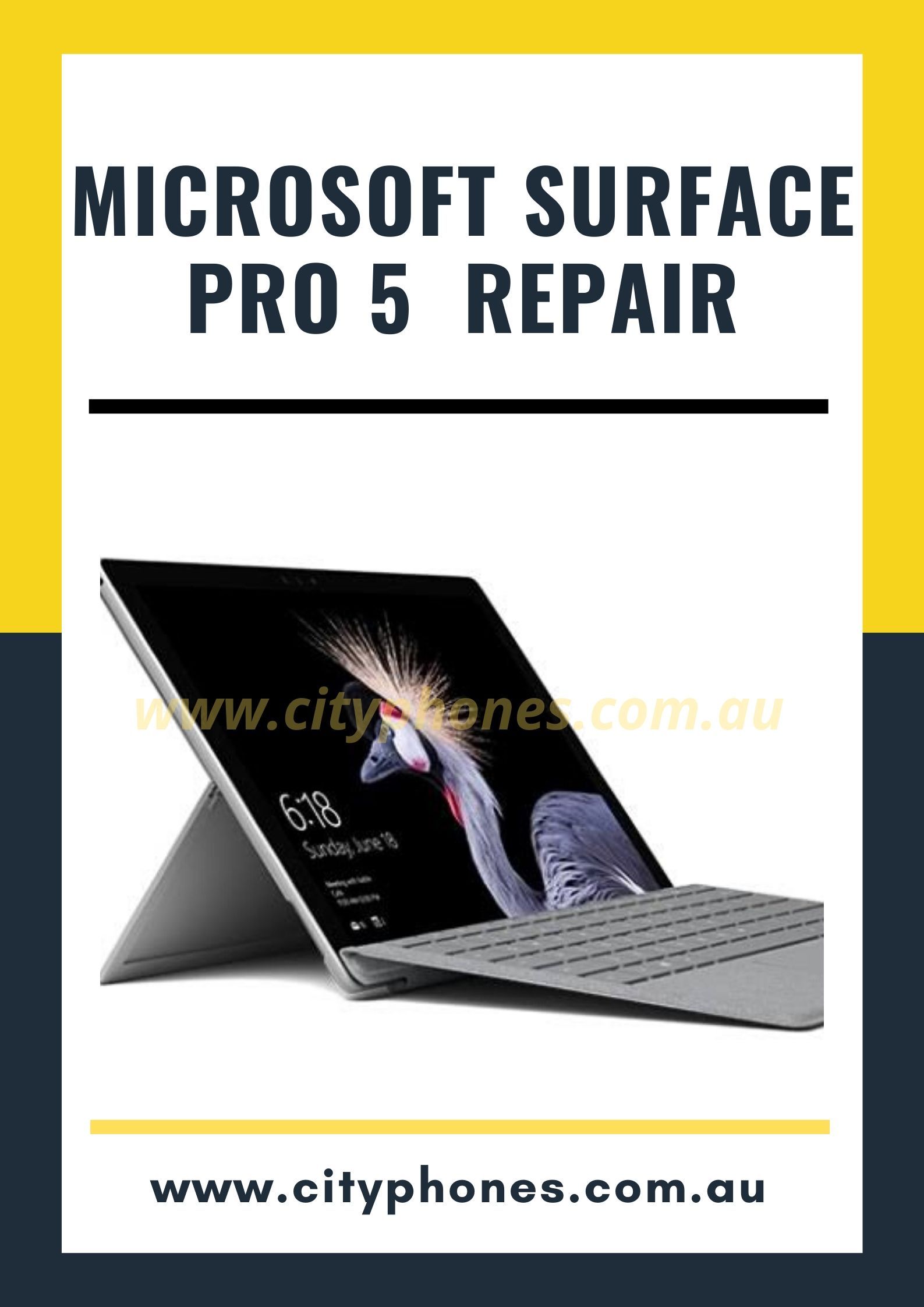Microsoft Surface Pro 5 SurfaceConnect Port Replacement
Duration: 45 minutes
Steps: 36 Steps
Heads-up: There’s a fair chance the delicate display panel could crack under pressure during this step. Take your time and handle it gently!
Ready to tackle the SurfaceConnect port on your Microsoft Surface Pro 5? Let’s roll! If you’re planning to give your Surface some extra love by applying new thermal paste to the CPU during reassembly, it could boost performance big time. Just make sure you’ve got fresh thermal paste and either high-concentration isopropyl alcohol or a dedicated thermal paste cleaner handy. Heads up though—this step comes with risks. The display panel is both unreinforced and super delicate, so there’s a chance it could break. Be generous with the heat and take it slow and steady during the prying stage. You’ve got this!
Step 1
Make sure your Surface is completely powered off before diving into the teardown.
You can use a hair dryer, heat gun, or hot plate to warm things up, but tread lightly—too much heat can seriously mess up the screen or internal battery.
Keep it cool but keep it hot—reheat and reuse the iOpener a few times to get that Surface nice and toasty. Stick to the iOpener guidelines so you don’t overdo it!
– First, let’s keep things safe! If your screen’s glass is cracked, contain the breakage and protect yourself from potential harm by covering the glass with clear packing tape. Just lay down some overlapping strips until the whole screen is covered, and don’t forget to wear those safety glasses to keep your eyes protected.
– Now, grab your iOpener and heat it up. Apply it to the right edge of the screen for about two minutes – this will help loosen things up and make the repair process smoother.
Tools Used
Step 2
– Get familiar with the layout of the screen adhesive—it’s like a map for smooth sailing ahead.
– This zone here? It’s all adhesive, so you’re safe to cut without worries!
– Watch out near the edges! The display board and flex cables are hanging out close by. Slice gently and don’t go too deep under the display.
– Heads up for fragile antenna cables under this screen section! Stick to the guide and keep steady hands to avoid harm. Oh, and heads up—it’s also where the adhesive gets extra chunky!
Step 3
Keep the opening pick shallow—just till the black bezel on the screen’s side. Push it too far, and the LCD might end up crying for help.
– Grab an opening pick and slide it into the speaker opening on the screen, then run it gently under the glass. Keep it chill—don’t push the pick into the speaker grille, as it’s super delicate and can tear easily.
Step 4
– Twist the pick down towards the bottom of the Surface and glide it under the lower edge of the speaker cutout—smooth moves, you’re doing great!
Step 5
If your pick feels like it’s wrestling with the glass, take a breather and reheat the area you’re working on. Don’t try to strong-arm it—too much force can shatter the glass!
– Glide your pick along the right edge of the Surface to slice through that stubborn screen adhesive—you’re almost a pro already!
– Keep that pick snugly parked in the right edge. It’ll act as a trusty wedge to keep the adhesive from sticking back together.
Step 6
You can use a hair dryer, heat gun, or hot plate for some extra warmth, but watch out—too much heat can be a real bummer for your Surface. The screen and internal battery are sensitive to overheating, so keep it cool and steady!
Keep your cool, but warm up the Surface! You might have to reheat and reapply the iOpener a few times to get it just right. Stick to the iOpener instructions so nothing gets too hot to handle.
– Warm up that iOpener and give it a cozy spot on the bottom edge of the Surface’s screen for a solid two minutes.
Tools Used
Step 7
Keep it chill—don’t slide the opening pick in deeper than the black bezel along the screen’s edge. Going too far could mess with the LCD, and nobody wants that!
– Start by sliding a fresh opening pick into the bottom right corner. Gently glide it around the corner towards the bottom edge.
– Now, carefully move the pick along the bottom edge to slice through the screen adhesive.
– Leave the pick in place at the bottom to stop the adhesive from sticking back together.
Step 8
You can use a hair dryer, heat gun, or hot plate for some extra warmth, but watch out—too much heat can be a real bummer for your Surface. The screen and internal battery are sensitive to overheating, so keep it cool and steady!
Keep it chill and steady—you might need to reheat and reapply the iOpener a few times to get the Surface warmed up just right. Stick to the iOpener instructions, and you’ll avoid any overheating drama.
– Warm up the iOpener and gently place it on the left side of the Surface’s screen for about two minutes.
Tools Used
Step 9
Be super careful when you’re cutting along the lower 2.5 inches (65 mm) of the left edge! Keep that opening pick no deeper than 1/8 inches (3 mm) here. The display cables love to hang out right in this area and they can get hurt easily. Once you’ve safely navigated past the display cable zone, remember to keep the pick within the bezel. You’ve got this!
– Pop a new opening pick into the bottom left corner and glide it around the edge like you’re slicing cake—toward the left side.
– With steady vibes, drag the pick down the left edge of the Surface to work through that stubborn screen adhesive.
– Keep that pick snug in the left edge to stop the adhesive from acting clingy and resealing itself!
Step 10
You can use a hair dryer, heat gun, or hot plate to add some extra heat—just keep it chill and don’t let things get too toasty! The screen and the internal battery don’t vibe well with excessive heat.
The adhesive is thickest on this side, so you might need to heat things up and reapply the iOpener a few times to get the Surface nice and warm. Keep an eye on the iOpener instructions to avoid overheating—slow and steady does the trick!
– Give your iOpener a quick reheat and pop it onto the top edge of the Surface’s screen for a solid two minutes to soften things up.
Tools Used
Step 11
Now it’s time to tackle the top edge of the case. The next 6 inches (15 cm) are home to the left and right antennas, which are snugly sandwiched between the case and the screen bezel. Let’s get through these next steps with care – we don’t want any accidental antenna damage!
– Swing around that left corner with your opening pick, gliding it smoothly along the top edge of the Surface. Hold up when you’re 2.75 inches (70 mm) away from the left edge—precision is key!
Step 12
Keep the pick level with the screen the whole time so it doesn’t snag on the antennas. Avoid pressing the pick against the case.
– Slide the tip of your pick under the display where you just finished cutting—easy does it, no need to go deeper than the edge of the bezel.
– Give the pick a gentle roll to the right, pressing its long edge into the sticky screen adhesive under the bezel. Slice through that adhesive nice and smooth, but don’t drag the pick along the edge—keep it steady!
– Keep repeating: insert the pick tip where you just cut, roll it to the right, and slice your way across the top edge of the Surface. Stop when your pick is 2.5 inches (64 mm) from the right edge of the Surface.
Step 13
– After you’ve snipped away the adhesive near the antennas (that’s about 8.5 inches or 22 cm from the left edge), gently slide the pick along the top edge and gracefully curve around the top right corner to slice through any stubborn adhesive still hanging on. You got this!
Step 14
Don’t jump the gun just yet! The screen is still hooked up to the motherboard by two sneaky cables, so hold off on removing it for now.
– Gently lift the screen assembly away from the Surface case. If you feel any resistance, pause for a moment and make sure all the adhesive has been released.
– Grab an opening pick and carefully slice through any leftover adhesive.
– Watch out for the flash lens as it might pop out of the Surface case. Keep an eye on it and make sure to place it back into its spot during reassembly.
Step 15
– Gently lift the top of the screen assembly away from the case while coaxing the bottom of the screen closer to those shiny motherboard display connectors.
– Carefully lay the screen down on the case with the connectors facing up. Remember, be gentle with those display cables—no creasing allowed!
Step 16
Be gentle with that shield—it’s going to be a temporary parting, and you’ll want it to fit nicely when you put it back together later.
– Grab your trusty opening pick and gently shimmy it under one edge of the EMI shield that’s hugging the display board—go slow and steady, no rush!
– Work your way around the shield, hitting different spots and prying carefully until it gives up and pops off.
Step 17
– Gently lift the EMI shield off the display board—almost like you’re revealing a secret—and set it aside.
Step 18
– Grab a flat end of your spudger and gently pop that display interconnect cable straight up and out of its snug little socket on the board. Take it nice and easy—you’re doing great!
Tools Used
Step 19
Keep the shield looking sharp—you’re going to need it back in action during reassembly, so try not to bend it out of shape.
– Grab a pair of pointed tweezers and carefully slip one tip into the gap along the edge of the EMI shield covering the digitizer connector.
– Gently use the tweezers to lift the EMI shield away from the display. Be careful not to bend it, just give it a little nudge.
– Work your way around the shield, repeating the process at different points until it pops free. Once it’s loose, go ahead and remove it.
Tools Used
Step 20
– Gently yank the shield off the digitizer connector like you’re peeling a sticker, and set it aside gracefully.
Step 21
– Gently use the edge of your spudger to pop the digitizer connector straight up—it’s like unplugging a tiny puzzle piece—right out of its snug little socket on the screen!
Tools Used
Step 22
– Lift off the screen assembly from the Surface—nice and steady does it!
– When putting it all back together, stop here to refresh the screen adhesive by following this guide. It’ll look as good as new!
Step 23
– Grab a spudger and use its pointy end to gently pop the microphone connector straight out from its cozy little spot on the motherboard. Easy does it—precision is your best friend here!
Tools Used
Step 24
– Grab your trusty T5 Torx driver and take on the four screws holding the antenna support in place:
– Three screws measuring 4.5 mm each
– One screw that’s 6 mm long
Step 25
– Grab your trusty spudger and gently pry up the antenna support from its little nook in the Surface—it’s like freeing a tiny piece of tech treasure!
– Pop that antenna support out of its spot and call it a day!
Tools Used
Step 26
Try to keep the shield’s shape intact—it’ll need to go back in place later during reassembly.
Be super careful with those tweezers—accidentally poking the battery would be a major no-go!
– Take the pointed tips of a pair of tweezers and gently sneak one point into a corner gap of the EMI shield that’s hiding the heat sink.
– Now, use those tweezers to tease the EMI shield away from the motherboard as far as you can—just be careful not to bend it! Leave it attached for now.
Tools Used
Step 27
– Now, let’s get all the corners covered – literally! Repeat the last step for each corner of the EMI shield that’s covering the heat sink. You’re doing great, and you’re one step closer to getting your device up and running!
Step 28
– Take off the heat sink shield and set it aside. You’re doing great!
Step 29
– Pop out those ten Torx screws holding the heat sink in place—you’re doing great!
– When it’s time to put things back together, tighten the heat sink screws in this awesome criss-cross pattern. Go one turn at a time, making sure they’re snug as a bug:
– Five screws are 2.6 mm-long T3 screws—don’t mix these up!
– Four screws are 3.3 mm-long T5 screws—keep track of these too!
– Start with Screw 1, then hop over to Screw 2.
– Next, go for Screw 3, and finally, wrap it up with Screw 4.
Step 30
Be gentle when removing the heat sink pipes to avoid bending or creasing them. We want to keep everything in great shape for a successful repair!
– Grab the flat end of your trusty spudger and gently lift the heat sink straight up off the CPU like you’re peeling a sticker—slow and steady wins the race!
– When putting things back together, be sure to give the heat sink and CPU a good cleaning and lay down some fresh thermal paste. Your CPU deserves the VIP treatment!
Tools Used
Step 31
Be gentle with that shield—it’s going to be a temporary parting, and you’ll want it to fit nicely when you put it back together later.
– Grab your trusty pointed tweezers and carefully slide one tip into a gap at the corner of the EMI shield covering the microSD card reader connector.
– Gently use the tweezers to pry up the EMI shield, but don’t go too hard—keep it steady and avoid bending it!
– Work your way around the shield, repeating this technique in different spots until it’s totally free. Once it’s loosened, take it off and set it aside!
Tools Used
Step 32
– Grab the flat tip of your trusty spudger and gently lift the microSD card reader connector up and away from its cozy spot in the motherboard. Easy does it!
Tools Used
Step 33
– Time to get started! Use the flat end of a trusty spudger to carefully pry up the flap covering the Surface Connect port connector. Take your time, it’s an easy step!
Tools Used
Step 34
– Gently wiggle the SurfaceConnect port connector free from the motherboard socket—it’s like unplugging a tiny robot, so be patient and smooth.
Step 35
– Grab your trusty T5 Torx driver and unscrew the two 3.7 mm screws holding the SurfaceConnect port in place.
Step 36
– Before you install the new part, take a moment to compare it with the old one. If needed, move any leftover components or peel off those pesky adhesive backings from the new part.
– Reassembling your device? Just retrace your steps in reverse, and you’ll be good to go.
– Got e-waste? Be sure to drop it off with an R2 or e-Stewards certified recycler for safe disposal.
– Repair didn’t quite go as planned? No worries! Give some basic troubleshooting a try or reach out to our Answers community for help.
– Need extra help? If things feel tricky, you can always schedule a repair.














































































